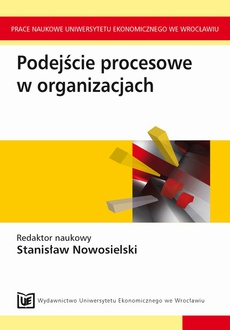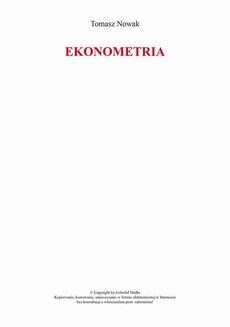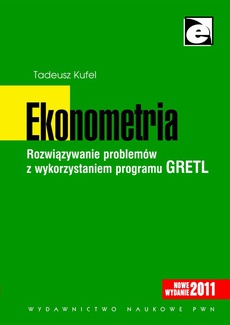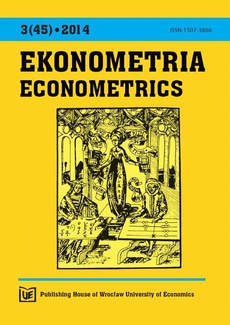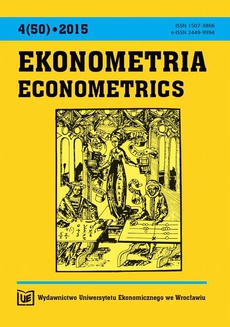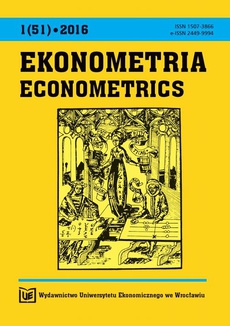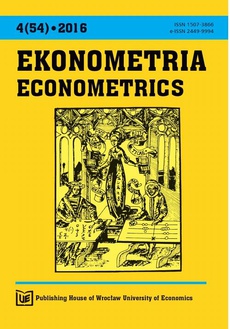POLECAMY
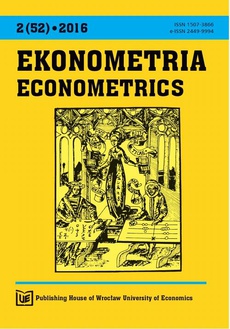
Ekonometria 2(52)
Praca zbiorowa
Format:
ibuk
The fifty-second issue of the Econometrics contains eight articles. The first of them, by Marek Walesiak, is related to the visualization of linear ordering results with the application of multidimensional scaling. Radosław Mącik, in his article presents practical and theoretical remarks of the visualisation of nominal data. The article by Marcin Pełka and Andrzej Dudek is dedicated to regression analysis for interval-valued symbolic data. Justyna Brzezińska presents a polytomous item response theory models using R. The next article is related to the measure of spirituality and sensitivity at the workplace. This paper was written by Maria Straś-Romanowska, Jolanta Kowal and Magdalena Kapała. The article by Iwona Dittmann is related to open-end debt investment funds and bank deposits in Poland in the years from 1995 to 2015. Jan Kaczmarzyk presents in his article reflecting interdependencies between risk factors in corporate risk modelling using the Monte Carlo simulation. The last article, by Eliza Khemissi, concerns the problem of the monotonicity of some popular risk measures.
Dear Authors and Reviewers,
Econometrics is constantly at the forefront of scientific journals in Poland. On December 23rd 2015, there appeared a Communication from the Polish Minister of Science and Higher Education regarding the list of scientific journals. Econometrics obtained 14 points. Apart from that, as a result of the evaluation of scientific journals conducted by Index Copernicus International, Econometrics achieves higher score from year to year. The grade earned for 2014 was 75.77 points (a normalized value of 7.3 pts.). We are constantly making efforts to obtain an even higher evaluation in the years to come. Our purpose is to introduce Econometrics to the A list. For this reason, from next year most of the articles will be published in English.
Jozef Dziechciarz
Editor In-Chief
| Rok wydania | 2016 |
|---|---|
| Liczba stron | 122 |
| Kategoria | Publikacje darmowe |
| Wydawca | Wydawnictwo Uniwersytetu Ekonomicznego we Wrocławiu |
| Język publikacji | polski |
| Informacja o sprzedawcy | ePWN sp. z o.o. |
Ciekawe propozycje
Spis treści
| Preface | 7 |
| Marek Walesiak: Visualization of linear ordering results for metric data with the application of multidimensional scaling / Wizualizacja wyników porządkowania liniowego dla danych metrycznych z wykorzystaniem skalowania wielowymiarowego | 9 |
| Radosław Mącik: Visualisation of nominal data – practical and theoretical remarks / Wizualizacja danych mierzonych na skali nominalnej – uwagi praktyczne i teoretyczne | 22 |
| Marcin Pełka, Andrzej Dudek: Regression analysis for interval-valued symbolic data versus noisy variables and outliers / Regresja liniowa danych symbolicznych a zmienne zakłócające i obserwacje odstające | 35 |
| Justyna Brzezińska: A polytomous item response theory models using R / Politomiczne modele teorii odpowiedzi na pozycje testowe w programie R. | 43 |
| Maria Straś-Romanowska, Jolanta Kowal, Magdalena Kapała: How to measure spiritual sensitivity at the IT user’s workplace? The construction process and method of validation of Spiritual Sensitivity Inventory (SSI) / Jak zmierzyć duchową wrażliwość pracowników IT w miejscu pracy? Proces konstrukcji i metody walidacji inwentarza wrażliwości duchowej (SSI) | 53 |
| Iwona Dittmann: Open-end debt investment funds and bank deposits in Poland 1995-2015. A comparison of the a posteriori probability (chance) of failure to achieve the level of aspiration / Dłużne otwarte fundusze inwestycyjne oraz depozyty bankowe w Polsce w latach 1995-2015. Porównanie a posteriori prawdopodobieństwa (szans) nieosiągnięcia poziomu aspiracji | 77 |
| Jan Kaczmarzyk: Reflecting interdependencies between risk factors in corporate risk modeling using Monte Carlo simulation / Odzwierciedlanie współzależności pomiędzy czynnikami ryzyka w modelowaniu ryzyka działalności gospodarczej przedsiębiorstwa z wykorzystaniem symulacji Monte Carlo | 98 |
| Eliza Khemissi: Problems of monotonicity of some popular risk measures / Problemy monotoniczności pewnych popularnych miar ryzyka | 108 |










